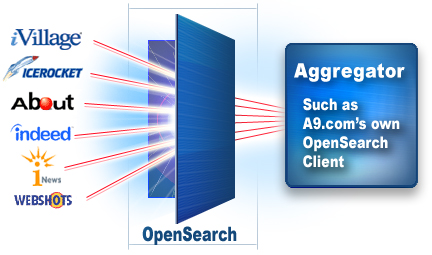OpenSearch is a standard way of querying a database for content and returning the results.
The official docs note simply: “Any website that has a search feature can make their results available in OpenSearch format,” then adds: “Publishing your search results in OpenSearch™ format will draw more people to your content, by exposing it to a much wider audience through aggregators such as A9.com.”
It’s a lot easier to understand OpenSearch once you’ve used it, so take a look at A9.com and do a search. A9 isn’t the only OpenSearch aggregator out there, but it’s a great example. You can query a number of OpenSearch targets by clicking the buttons to add columns (also try resizing the columns), or you can add any of the 422 public search targets listed at A9.
Now, if you’ve got the beta of IE 7, you can see how it’s extending beyond server-side aggregators and into client software. Even better, you can see how this is becoming automigical via autodiscovery.
One of the most exciting features of OpenSearch is its support for complex queries as well as simple keyword searches, and the ability to return intelligent responses to a search, such as alternate search suggestions (think spelling corrections) and facets (hey, any librarians attending this?)
Now, the question for libraries is when are we going to demand OpenSearch interfaces from our information providers? The inclusion of OpenSearch in IE7 more than gives it critical mass, but so far it seems to be just something a few progressive library-types are experimenting with. In the short term, imagine how improved our metasearch tools would be if based on fully-implemented OpenSearch feeds (with the facets and suggestions). In the long term, I can’t imagine any aspect of a library’s online services not touched by this technology.
